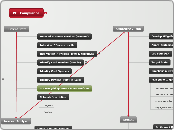PA2
ASPE TO IFRS
Things to consider
increased costs
increased reqporting and disclosures
complex
BUY or LEASE
Buy
how to finance
check CF
if CF is an issue
issue shares
financing thru banks
if there is bank covenant
covenant on ST debt
combo equity & LT debt
bonds
covenant on LT debt
consider equity financing
Lease
is there ownership or bargain purchase option
NO
Is lease term >= 75% of economic life
Is PV of pmts >=90% of FV
OPERATION LEASE
CAPITAL LEASE (IFRS) or FINANCE LEASE (ASPE)
ASPE
YES
CAPITAL LEASE
EXPANSION
TX: MPP deduction
NEED FOR CAPITAL BUDGET
RISKS
Operational risks
decrease in productivity
Equipment obsolence
Credit/Default risks
Stakeholders risks
key employees
CF risks
Business risks
Current financing options
Raising capital
Ways to raise capital
If public
Going IPO
Disadvantages
increase accountability,disclose compensation of executives and MD&A,interin financial statements,change in control,substantial costs for IPO i.e. legal,underwriter,securities registration,consulting,audit fees,loss of small business deduction, increase financial reporting and auditing requirements, must use IFRS.
Advantages
increase access to capital,improve ratios i.e.debt to equity,current ratio,financial leverage,increase cashfrom sale of shares,negociate better interest,increase consumers awareness.
Stock offering
Stock rights
will maintain current s/h ownership %
offer current s/h option to purchase additional shares
Preferred shares
Advantages & disadvantages
Disadvantages:cumulative feature may impose cash flow issues in a later year,not deductible for tax
Advantages:avoids dilution of ownership,can omit dividends in bad years,do not reduce reported income,improve debt to equity ratio if treated as equity.
features of the shares will determine if:
LIABILITY
redeption is at the s/h's discretion
cumulative at x%,callable,convertible
EQUITY
redemption is at company's discretion
paid before common shares
paid after bondholders are paid their guaranteed interest payment
paid when declared
Common shares
CON: will dilute ownership, change direction & focus of company,increase the probability of takeovers by a small margin, the new skares may depress stock price during and soon after issue of new shares.
PRO: attracts new s/h, no legal requirements to pay dividends,teherby reducing financial distress or insolvency,improve debt to equity covenants,dividends do not decrease reporting earnings.
TX: interest paid on bonds are tax deductible,thereby reducing after tax cist of capital
increase debt to equity covenants,potential loss of flexibility in future financing
If private
IPO
Issues with raising IPO
IT: must have financial system in place to produce timely, reliable, relevant F/S
FR: requires 2 years of financial records, must hire auditor
Complexities: increase reporting requirement, audited F/S, MD&A
Costs: prospectus prep, legal fees, registration, increase cost of assurance, implementation of more internal control
Borrowing
Restrictive covenants
cost of violating covenant: increase financing cost, loss of reputation, loss of sale, decrease in EPS
must comply with lending body (DO NOT VIOLATE)
Debt-to-equity ratio= total liab / shareholders equity
Working capital = current assets - current liabilities
Issue bonds
TX: interest paid on bonds are tax deductible
MUST PAY interest when not profitable
Using profits
CF if available
Main topic
MUDRA APPARELS LTD.
MEMO to CEO
risk management
Subtopic
MEDIUM
closing of plant
LT: employees may leave, expertise will be gone
ST: dec market share, loss of sales, dec EPS, dec SW
HIGH
acccounting issues
buy & lease
lease
good idea
cash management policy
cash budget
keep reserve
foregoing oppotunity cost
just bec there is excess cash, don't buy machines outright
QA
possible replacement
ongoing r&m
increased cost related to breakdown of equipment
link to I/S and GM
GM dec eventhough revenue increase
F/S presentation?
IFRS - absorption cost
inventory
production line is aligned to marketing and meeting sales projections (budget)
determine which section (clothing or accessories) is bringing in more sales (quality earnings)
bank requirements
LT: increase sales and deal with inventory issue
ST: infusion of cash from sale of the laser-cutting machine will improve current ratio
working capital
current ratio
acid test will indicate issues with inventory
MEMO to BD
market share
preliminary market research
increase market share by building the new facility
improve product quality
currently, not meeting targets (not meeting market needs)
not meeting targe
high inventory
expansion
negotiating point for bank if we lower covenant by selling laser-cutting machine
based on 20X5 R/E, retain R/E in pfd shares for expansion
disclosure of expansion in MD&A
gain bigger market share
will improve product quality
consider keeping the current facility open
keep skilled employees
recalculate NPV
qualitative factors
capital budget
scale down
financial results shows that we cannot carry more debt
strategic partners
common shares
dividend policy
preferred shares
features
accelerated rates
goes up - liability
redemption option
owner - liability
corporation to redeem - equity
dividends not tax deductible
stock rights
although, issuing bond is an option
INVENTORY VALUATION
net realizable value
BONUS PLAN
Ethics
manipulation of earnings
FR
timely, reliable, relevant information that captures data tied to the bonus plan
IT
link to financial system
a more robust IT is required to track the non-financial data
MA
better to use financial & non-financial data such as balanced scorecard
customers - market share, customer satisfaction measures, customer loyalty
leadership & training - morale, knowledge, turnover, use of best demonstrated practices
business processes - eliminatiion of bottlenecks, timeliness, productivity rates
financial - revenue, net income, return on capital, CF
using financial aspect only may lead to manager manipulating accounting policies
need for earnings management
(moral hazard) manager may shirk responsibilities
TAX
pay out within 180 days to be tax deductible









